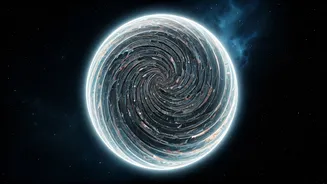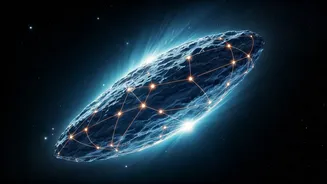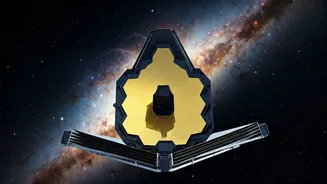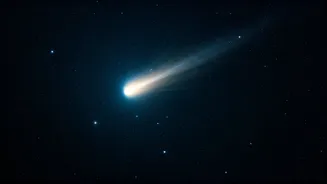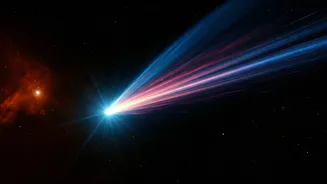Comet 3I/ATLAS Unveiled
Comet 3I/ATLAS, a celestial wanderer hailing from interstellar space, has caught the attention of scientists and space enthusiasts alike. Its rare nature
as an interstellar visitor sets it apart from comets originating within our solar system. The comet's trajectory and composition are of significant interest as they offer valuable insights into the formation of planetary systems beyond our own. As it journeys through space, scientists closely monitor 3I/ATLAS, studying its behavior to understand its characteristics. Its passage near Earth provides a unique opportunity for observation and the gathering of data, which could reshape our understanding of the cosmos. The significance of this comet lies in its ability to offer clues about the early universe and the processes that shape celestial bodies across galaxies.
Mysterious Signal Detection
The intrigue surrounding 3I/ATLAS deepened with the detection of a peculiar signal. The comet has been observed transmitting a stable signal at 1420 MHz. The signal’s most distinctive feature is its Fibonacci pattern, which is represented by the sequence 8 • 13 • 8 • 5 • 13 • 8. This mathematical pattern, where each number is the sum of the two preceding ones, is a common occurrence in nature. The signal's consistent transmission and the specific frequency have sparked discussions among experts. This has resulted in several theories about its origin and purpose. Its precise characterization is essential in determining whether the signal is a natural phenomenon or a deliberate transmission. The scientific community is currently investigating the signal to determine its precise source.
Fibonacci Sequence Explained
The Fibonacci sequence, a cornerstone of mathematics, is a sequence of numbers where each number is the sum of the two preceding ones. This sequence begins with 0 and 1, continuing with 1, 2, 3, 5, 8, 13, and so on. The appearance of this sequence is widespread in nature, ranging from the arrangement of petals on a flower to the spiral patterns of galaxies. It is a symbol of order and inherent design. The presence of a Fibonacci pattern in the signal from 3I/ATLAS has caused great excitement. This has led scientists to speculate about the meaning of this pattern. Its ubiquitous nature makes it difficult to definitively conclude the signal's origin. The Fibonacci sequence, regardless of its source, underscores the interconnectedness of mathematics and the universe.
Possible Signal Origins
The origin of the signal emanating from 3I/ATLAS is a primary focus of scientific research. One possibility is that it is a natural phenomenon, a result of the comet's unique composition or interaction with space. Alternatively, the signal may be the product of some kind of extraterrestrial intelligence. If the signal is intentional, the Fibonacci pattern could be a form of coded communication, a signal intended for a potential receiver. This would be a remarkable development in the history of space exploration. Experts are actively analyzing the signal’s characteristics, searching for any clues to its source. The study of the signal's origin is therefore of paramount importance.
Analyzing the Signal
To ascertain the signal's nature and source, scientists are applying different analytical methods. They are studying its frequency, the specific wavelengths at which it is transmitted, and the signal's modulation, or how the information is encoded. The signal is being examined for any patterns that could provide hints about its origin. Scientists are also cross-referencing this information with existing data about the comet's composition and behavior. This approach aims to determine if the signal could be a natural event, or if it has another origin. The thorough analysis of this signal is critical to resolving the enigma of 3I/ATLAS.
Significance of 1420 MHz
The signal's frequency, specifically 1420 MHz, is an important element in understanding its significance. This frequency is particularly interesting since it is also the frequency at which neutral hydrogen emits radiation. This frequency is commonly used in radio astronomy to study interstellar hydrogen, which is a major component of the cosmos. The choice of this frequency, either by natural processes or by another intelligence, may be more than mere coincidence. This has created discussions about its potential role in astronomical research or as a targeted communication channel. The frequency itself might be a clue, and scientific interpretation of this aspect of the signal is essential.
Impact on Understanding
The detection of a Fibonacci-patterned signal from 3I/ATLAS presents a significant opportunity to advance our cosmic knowledge. The discovery could challenge current assumptions about the universe. It could lead to the discovery of new phenomena or, in the case of extraterrestrial communication, transform human understanding of our place in the cosmos. In either situation, the analysis of the signal is set to drive interdisciplinary scientific collaboration. This event could potentially create breakthroughs in both astronomy and SETI studies. The impact of the signal from 3I/ATLAS might lead to new scientific revelations.
